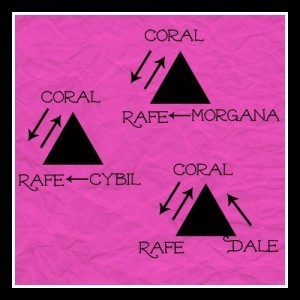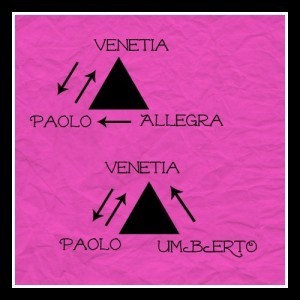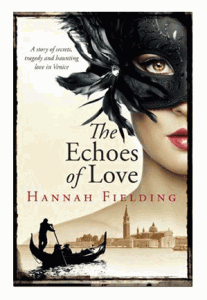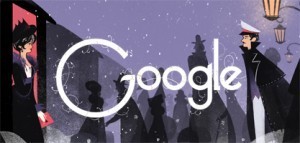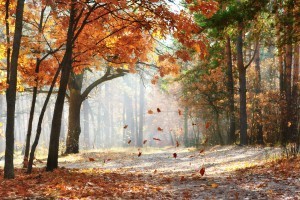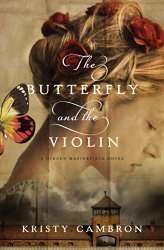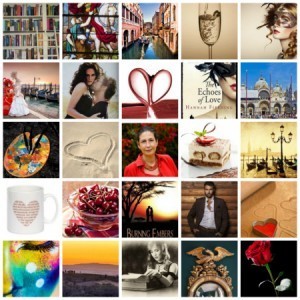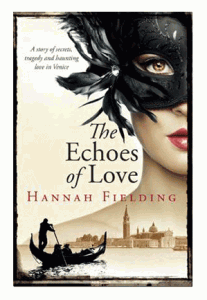Hannah Fielding's Blog, page 96
September 21, 2014
Muddying the path of true love: Love triangles
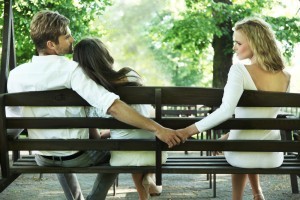 The course of true love never did run smooth’ – so wrote Shakespeare in A Midsummer Night’s Dream, and I think that no single axiom is more explored in romantic fiction! A romance story that unfolds simply, without a hiccup, is delightful, but uninteresting in literary terms. So authors create a set of obstacles to throw, with Machiavellian intent, into the path of the lovers. All sorts of obstacles exist, from social pressures to physical separation, illness to ideological differences, but perhaps the most classic and the most compelling is the introduction of The Other Woman or The Other Man.
The course of true love never did run smooth’ – so wrote Shakespeare in A Midsummer Night’s Dream, and I think that no single axiom is more explored in romantic fiction! A romance story that unfolds simply, without a hiccup, is delightful, but uninteresting in literary terms. So authors create a set of obstacles to throw, with Machiavellian intent, into the path of the lovers. All sorts of obstacles exist, from social pressures to physical separation, illness to ideological differences, but perhaps the most classic and the most compelling is the introduction of The Other Woman or The Other Man.
Enter the love triangle, with its many variables, the most popularly used of which are:
Characters B and C love Character A, and Character A loves Character B only. I call this the One-Left-Out Triangle.
Characters B and C love Character A, and Character A is torn between Characters A and B. I call this the Torn Triangle.
In my novels, I like to really challenge my protagonists and test the strength of their love. That is why I often incorporate love triangles for both the hero and the heroine.
In Burning Embers, I incorporate three.Rafeis in love with Coral, but two other women, the bewitching Morgana and Cybil, Coral’s stepmother, are vying for his attention. Coral, meanwhile, is in love with Rafe, but her adulterous ex-fiancé eyes her with intent. The result looks something like this:
In The Echoes of Love, Paolo is in love with Venetia, but his charge, the wild young woman Allegra, is passionately possessive of him. Meanwhile, the heroine, Venetia, is falling in love with Paolo, but another man, Count Umberto, covets her.
In these books I stick to One-Left-Out triangles, but in the upcoming book (news on that one soon!) I develop a Torn Triangle, and all the confusion and longing that creates.
I don’t include love triangles superficially in my writing, as a means to throw up a quick and easily resolved issue in the story. The human heart is so deeply complex and riddled with conflicting emotion that I use love triangles to force the protagonists to really explore themselves and their true desires.
I also like the drama and high emotion they bring to the narrative. In The Echoes of Love, the Count and Paolo are friends, which places Venetia in an impossible situation – how can she tell Paolo of the Count’s lecherous advances on her? And then there is Allegra, dangerous in her desperation to keep hold of Paolo – so desperate she will resort to violent destruction. In Burning Embers, Cybil is manipulative and cunning, and determined to keep Rafe from Coral.And as for the sultry dancer, Morgana – how can the unworldly Coral stand firm in the face of this woman who tells her that Coral is merely a dream and that she is the reality to which Rafe must cling in order to survive?
Ultimately, both novels are the stories of lovers finding the courage to trust each other and to let go of their pasts – but they are also stories of people struggling against people, of love vanquishing envy and possessiveness. The battle is on, and the stakes are high: the winner attains the happy ever after.
And what of The Other Men, Dale and Umberto, and The Other Women, Cybil and Morgana and Allegra? Well, the all-powerful author has the means to leave those who play unfairly, those who are selfish and manipulative and would destroy the happiness of those they purport to love, to reap the effects of karma. But if any should redeem themselves, acquiesce and know that when you love someone, sometimes all you can do is set that person free – then, perhaps, that person deserves their own happy-ever-after. And I’ve a mind, one day, to write that story. About whom? Well, you’ll have to read the books and then decide…
September 19, 2014
Stuck in a Good Book Giveaway Hop
I’m delighted to be participating in this Stuck in a Good Book Giveaway Hop. I’m giving away two paperback copies of my epic romance novel, The Echoes of Love, a passionate love story set in Italy.
The Echoes of Love is a beautiful, poignant story of lost love and betrayal, unleashed passion and learning to love again, whatever the price. Venetia Aston-Montague has escaped to Italy’s most captivating city to work in her godmother s architectural practice, hoping to put a lost love behind her. Paolo Barone, a charismatic entrepreneur who bears the scars of a tragic past, is endeavouring to build a new life for himself. Venice on a misty carnival night brings these two people together. When Venetia finds herself assigned to Paolo s magnificent country home, love blossoms in the beautiful hills of Tuscany and the wild Sardinian Maquis. But if they are to be together, they must first confront their past and dark forces in the shadows determined to come between them. Daring to love again after so many years, can Venetia overcome her own demons? Or will Paolo’s carefully guarded, devastating secret tear them apart forever?
To enter, simply comment on this blog post, telling me why you’d like to read my book. The hop ends on 25 September, so post before the end of that day. Entries from all over the world are welcome. Good luck!
And now, why not visit some of the other participants in the hop for a chance to win other great books and goodies…
Powered by Linky Tools
Click here to enter your link and view this Linky Tools list…
September 18, 2014
Promoting literature with the Google doodle
Do you use Google as a browser? If so, you may have noticed, on 9 September, that Google marked 186 years since the birth of writer Leo Tolstoy with a slideshow of images: from Tolstoy writing by candlelight, to the first meeting of Anna and Vronsky in Anna Karenina, and Pierre Bezukhov of War and Peace captured in this moment:
He gazed joyfully, his eyes moist with tears, at this bright comet which, having travelled in its orbit with inconceivable velocity through immeasurable space, seemed suddenly – like an arrow piercing the earth – to remain fixed in a chosen spot, vigorously holding its tail erect, shining and displaying its white light amid countless other scintillating stars. It seemed to Pierre that this comet fully responded to what was passing in his own softened and uplifted soul, now blossoming into a new life.
The artist of the doodles, Roman Muradov, is reported in the Guardian as having found the task daunting, but said he hoped his artwork would “inspire viewers to discover and revisit these scenes in the way Tolstoy intended: through reading and rereading his timeless narratives”.
The Google doodle, as is called, was devised by the Google founders, and was first trialled in 2000 to celebrate Bastille Day. That first doodle was so popular, more doodles were created until Google hired an entire team of doodlers who, collectively, have created more than 2,000 doodles published on the homepage. Google notes that:
Doodles are the fun, surprising, and sometimes spontaneous changes that are made to the Google logo to celebrate holidays, anniversaries, and the lives of famous artists, pioneers, and scientists.
‘Artists’ in this context includes writers – Google has published doodles commemorating the lives and works of writers as diverse as Zora Neale Hurson, Mark Twain, Jorge Luis Borges, Herman Melville and Elizabeth Barrett Browning. In doing so, Google bringswriters before millions of people worldwide. What power it wields!
Could the Google doodle be a useful tool in reviving the classics? In promoting literacy? In encouraging those who don’t read to read, and those who do to try out new works? I hope so – but while I admire the doodlers’ ability to pictorialize a work of literature, I would love to see quotations worked into the doodle – for it is the words that matter most, and the words that have most power to engage.
What do you think? Do you notice the doodles? Do they affect you? What doodles would you like to see incorporated? If you’re a Google user, you can suggest your own ideas via proposals@google.com.
September 16, 2014
A very Venetian bookstore
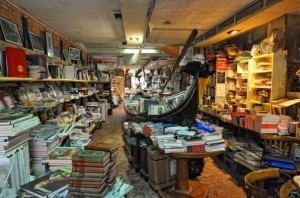 When I travel to a new city, I’m always interested to see the main sights. In Venice, for example – where I went recently to get a feel for the setting in my latest novel, The Echoes of Love – I followed the crowds to all the main attractions: St Mark’s Square, with its Basilica and the Doge’s Palace; the famous Bridge of Sighs; the Grand Canal; galleries and churches and palaces aplenty; and of course the islands of Burano, Murano and Torcello. But I also like to go off the beaten track, and explore the true city – the face beneath the mask. My heroine, Venetia, lives in Venice and frequents the little boutiques and cafes popular with the locals, which gave me the perfect excuse to step into the labyrinth of tiny lanes that lead away from the throngs into the true heart of the city.
When I travel to a new city, I’m always interested to see the main sights. In Venice, for example – where I went recently to get a feel for the setting in my latest novel, The Echoes of Love – I followed the crowds to all the main attractions: St Mark’s Square, with its Basilica and the Doge’s Palace; the famous Bridge of Sighs; the Grand Canal; galleries and churches and palaces aplenty; and of course the islands of Burano, Murano and Torcello. But I also like to go off the beaten track, and explore the true city – the face beneath the mask. My heroine, Venetia, lives in Venice and frequents the little boutiques and cafes popular with the locals, which gave me the perfect excuse to step into the labyrinth of tiny lanes that lead away from the throngs into the true heart of the city.
It was on one such exploration that I happened across a unique bookstore: LibreriaAcqua Alta, on the Calle Longa Santa Maria Formosa (Corte Senza Nome) in Castello. Regular readers of my blog will know that I am a bibliophile, and so the discovery of a bookshop will always be an exciting one! But this bookshop is really a sight to behold, not least because the first thing I saw upon entering was a gondola full of books…
The bookshop sells both new books and second-hand ones, but it does not have the stark, smart minimalism of a modern store; it has something of the feel of a French brocante. The rooms are labyrinthine and filled with books, on shelves, stacked on the floor, in a bathtub, even – keep exploring far enough and you find yourself in a courtyard from which extends steps made of books (signs direct you to ‘go up’ for a ‘wonderful view’; and indeed, the view of the canals is stunning, though it feels slightly wrong to be climbing books…).
The scent of paper is pungent in the air, and the eye is continually distracted by the somewhat haphazard organizing, but if you love to rummage, there are gems to be found, from dictionaries and atlases to romance and sci-fi novels, in all different languages.
‘LibreriaAcqua Alta’ translates to High Water Bookshop, which brings new meaning to the bathtub and gondola – when the water level rises in the canal outside, and the store floods, the books are safe! That perhaps also explains the lifebelt artfully arranged against a book stack.
I spent a very pleasant half hour in the bookstore, whose welcome sign proclaims it to be ‘the most beautiful bookshop in the world’. Certainly, it is the most unique I have been to, and I love the owner’s sense of humour and whimsy.
Have you been to any unusual bookstores like this one? I would love to hear about them and add them to my ‘visit wish list’.
September 15, 2014
Welcome autumn
It’s September, and while in England we’re enjoying a brief revival of summer’s warmth, the first yellowing leaves drifting on the breeze tell that autumn – fall – has tentatively arrived.I love the warmth of the spring and summer, but who can resist the kaleidoscope of colour that autumn creates? Mother Nature takes her palette and covers all with the every hue from gold to ruby.
To celebrate the autumnal awakening, all week I’m tweeting #WelcomeAutumn quotations, and today I’m sharing with you three of my favourite odes to autumn by classic English writers. As Jane Austen wrote, autumn is “that season which has drawn from every poet worthy of being read some attempt at description, or some lines of feeling”.I have highlighted some of my favourite phrases, those that echo in my mind as I walk through crisp fallen leaves.
Fall, leaves, fall by Emily Brontë
Fall, leaves, fall; die, flowers, away;
Lengthen night and shorten day;
Every leaf speaks bliss to me
Fluttering from the autumn tree.
I shall smile when wreaths of snow
Blossom where the rose should grow;
I shall sing when night’s decay
Ushers in a drearier day.
To Autumn by John Keats
Season of mists and mellow fruitfulness
Close bosom-friend of the maturing sun
Conspiring with him how to load and bless
With fruit the vines that round the thatch-eaves run;
To bend with apples the moss’d cottage-trees,
And fill all fruit with ripeness to the core;
To swell the gourd, and plump the hazel shells
With a sweet kernel; to set budding more,
And still more, later flowers for the bees,
Until they think warm days will never cease,
For Summer has o’er-brimm’d their clammy cells.
Who hath not seen thee oft amid thy store?
Sometimes whoever seeks abroad may find
Thee sitting careless on a granary floor,
Thy hair soft-lifted by the winnowing wind;
Or on a half-reap’d furrow sound asleep,
Drows’d with the fume of poppies, while thy hook
Spares the next swath and all its twined flowers:
And sometimes like a gleaner thou dost keep
Steady thy laden head across a brook;
Or by a cider-press, with patient look,
Thou watchest the last oozings hours by hours.
Where are the songs of Spring? Ay, where are they?
Think not of them, thou hast thy music too,-
While barred clouds bloom the soft-dying day,
And touch the stubble-plains with rosy hue;
Then in a wailful choir the small gnats mourn
Among the river sallows, borne aloft
Or sinking as the light wind lives or dies;
And full-grown lambs loud bleat from hilly bourn;
Hedge-crickets sing; and now with treble soft
The red-breast whistles from a garden-croft;
And gathering swallows twitter in the skies.
To Autumn by William Blake
O Autumn, laden with fruit, and stained
With the blood of the grape, pass not, but sit
Beneath my shady roof; there thou may’st rest,
And tune thy jolly voice to my fresh pipe,
And all the daughters of the year shall dance!
Sing now the lusty song of fruits and flowers.
The narrow bud opens her beauties to
The sun, and love runs in her thrilling veins;
Blossoms hang round the brows of Morning, and
Flourish down the bright cheek of modest Eve,
Till clust’ringSummer breaks forth into singing,
And feather’d clouds strew flowers round her head.
The spirits of the air live on the smells
Of fruit; and Joy, with pinions light, roves round
The gardens, or sits singing in the trees.
Thus sang the jolly Autumn as he sat;
Then rose, girded himself, and o’er the bleak
Hills fled from our sight; but left his golden load.
September 13, 2014
The Butterfly and the Violin by Kristy Cambron
From the blurb:
And then came war . . .
Today. Sera James spends most of her time arranging auctions for the art world’s elite clientele. When her search to uncover an original portrait of an unknown Holocaust victim leads her to William Hanover III, they learn that this painting is much more than it seems.
Vienna, 1942. Adele Von Bron has always known what was expected of her. As a prodigy of Vienna’s vast musical heritage, this concert violinist intends to carry on her family’s tradition and play with the Vienna Philharmonic. But when the Nazis learn that she helped smuggle Jews out of the city, Adele is taken from her promising future and thrust into the horrifying world of Auschwitz.
The veil of innocence is lifted to expose a shuddering presence of evil, and Adele realizes that her God-given gift is her only advantage; she must play. Becoming a member of the Women’s Orchestra of Auschwitz, she fights for survival. Adele’s barbed-wire walls begin to kill her hope as the months drag into nearly two years in the camp. With surprising courage against the backdrop of murder and despair, Adele finally confronts a question that has been tugging at her heart: Even in the midst of evil, can she find hope in worshipping God with her gift?
As Sera and William learn more about the subject of the mysterious portrait—Adele—they are reminded that whatever horrors one might face, God’s faithfulness never falters.
It was the beautiful cover of this novel that first caught my eye on NetGalley – followed by the title, which promises culture and romance. Then, once I read the blurb, I wondered whether it would be too hard a novel to read, given its Auschwitz setting. But the clear power of the story and courage of Adele that shine through in the blurb called to me, and so I requested the book for review. I’m so very glad that I did.
What a moving, beautiful, important, courageous and inspiring book.
From the outset, I was utterly drawn into the world of the book. I want to describe that world as fictional but of course it is not, entirely. The author has researched meticulously, and rendered a story whose 1940s sections are so real one can’t fail but be moved. The result, for me, was a haunting book that impelled me to read, read, read until the last words, and that stayed with me long after I finished. I was reminded of my reaction the first time I watched the movie Titanic: the emotional impact was vast, because the love story was rooted in a terrible reality.
I love the two stories, and how expertly the author intertwines them, so that whenever you are in one time, you are wondering about the other; so that the reader can take a much-needed break from the unbearable emotion wrought by Auschwitz back in the present, and then move back in time when she has gathered the courage to do so.
Courage – that is the word that echoes through me as I write this review.
The heroines in the book must be so courageous: Sera, the modern-day gallery owner, who has been so wounded by love that her faith is shaken and she struggles to trust any man again; Adele, Austria’s darling who has plummeted from grace for daring to protect Jewish friends, and must somehow find the strength to endure unspeakable evil.
So too was the author courageous in writing this book. To write of beauty and love amid the very worst of depravity and deprivation; to situate a love story in our world’s most horrific story of hate – I admire her greatly.
And of course the author who reads must have courage also. I did not find this an easy book to read, at times. Some of the details of life at the concentration camp, for example, I found deeply upsetting. But then, who am I to put down the book and walk away? These details are fact; they are truths that so many people lived through. I felt duty-bound to read on; to grieve for the past, but also to celebrate the beauty and the faith and the love that the author finds there. And without wishing to give any spoiler in this review, I felt that at the end of the book the author rewards the reader’s courage in walking the journey alongside Sera and Adele, and I was left wonderfully at peace and with a smile on my face.
This is romance at its most powerful. This is romance that is exquisitely beautiful and staggeringly poignant. This is romance, but so very much more.
This is a book we should all read, for its beauty, for its cathartic power, but above all, for its truth.
The Butterfly and the Violin is available now from Amazon; click on the book cover below to visit the store.
September 11, 2014
Audio books
 Did you know that audio books are a fast-growing sector in publishing? Between 2008 and 2013, revenue grew by 12 per cent annually to a massive $1.6 billion (source: IBISWorld). No longer are people complaining they don’t have time to read: they’re listening to books on their phones, their media players, in the car on the commute. Audiobooks have become de rigueur; no longer specialist creations for those with sight impairment. They’re quiteat home in a world where we naturally take in information from various sources at once and in which we’re increasingly interested in digital content. And on a cost basis, as an IBISWorld analyst explained:
Did you know that audio books are a fast-growing sector in publishing? Between 2008 and 2013, revenue grew by 12 per cent annually to a massive $1.6 billion (source: IBISWorld). No longer are people complaining they don’t have time to read: they’re listening to books on their phones, their media players, in the car on the commute. Audiobooks have become de rigueur; no longer specialist creations for those with sight impairment. They’re quiteat home in a world where we naturally take in information from various sources at once and in which we’re increasingly interested in digital content. And on a cost basis, as an IBISWorld analyst explained:
Because audiobooks are relatively cheap discretionary purchases that consumers can afford on tight budgets, the industry has been able to grow during the recession, despite consumers’ low disposable income.
IBISWorld predicted a rise in the number of companies producing audiobooks. Currently, Amazon has somewhere in the region of 90 per cent of the market. And challenging Amazon proves difficult.
Take My Audiobook Library. Its mission statement explains:
We believe there are many people out there that are in a similar situation but have never heard of audiobooks, and definitely don’t know that they can be downloaded instantly onto their computers and then to their MP3 Players so they can listen to their favorite books while on the go. We would like to help spread the word to the masses on how great audiobooks are and how they can greatly improve your quality of life.
The company plans to develop so that it can offer 55,000 titles at 30 per cent of retail prices. But growth is made difficult by Amazon’s monopoly. My Audiobook Library says:
Our customers want to listen to the New Releases from the Top Authors… but the ‘Big Five’ publishers are unwilling to partner with a company that does not already have a large customer base, and the kind of numbers they want, come from having audiobooks from the ‘Big Five’ publishers. Thus, the ‘catch-22.’.
But there’s hope: this company is running a campaign on Kickstarter which is garnering good support.
Where do I stand, as an author, vis à vis a audiobooks? I’m passionately in favour, and I count myself very lucky that my publisher, London Wall, is of a similar mind and so has created an audiobook of my latest novel, The Echoes of Love. The wonderful actor Matt Addis, who’s recently been in the touring production of War Horse, narrated the book. Here he is discussing the process:
September 9, 2014
Choosing the narrative mode for your novel
Last week I wrote about using the male point of view in romance fiction.Deciding on whose point of view you’re writingin is just one aspect of the narrative mode on which an author must decide before writing his or her book. This week I’m looking at two other aspects: the person view (in which person you write) and the tense.
The person view
You have three options:
The first person: I saw the ship.
The second person: You saw the ship.
The third person:She saw the ship.
The second person is used rarely, so most authors choose between the first and third person. In my writing, I favour the third person. Take the following paragraph from The Echoes of Love:
Paolo helped her with her coat, lifting her glorious long locks over the fur collar. At five foot seven inches, Venetia was tall but as he faced her and began buttoning the garment himself, she noticed again how he towered over her. His hands were strong and masculine; she had a curious sensation of warm familiarity, as though he had performed this act with her several times before. Yet mingled with that feeling came one of embarrassment; his touch seemed a rather intimate gesture instead of the impersonal indifference of a stranger, and she drew away with a little nervous laugh.
Writing in the third person allows me to give the reader a view of the whole scene, as a spectator. If I had written in the first person, the paragraph would read differently:
Paolo helped me with my coat, lifting my long hair over the fur collar. At five foot seven inches, I was tall but as he faced me and began buttoning the garment himself, I noticed again how he towered over me. His hands were strong and masculine; I had a curious sensation of warm familiarity, as though he had performed this act with me several times before. Yet mingled with that feeling came one of embarrassment; his touch seemed a rather intimate gesture instead of the impersonal indifference of a stranger, and I drew away with a little nervous laugh.
What do you think? I don’t believe it works as well in the first person. It’s inflexible: I’m stuck in Venetian so am unable to describe her hair in the same terms, for example. Also, the poeticism of the writing feels a little out of place if we’re inside Venetia’s mind, hearing her thoughts and interpretations. The first person works beautifully if you want your reader to live and breathe the heroine’s experience, but if you want your reader to see the story as a whole, within a setting and from all sides (much like watching a film or play), the third person works best.
Narrative tense
And what of the tense? Again, authors have three choices:
Past tense: I saw the ship.
Present tense: I see the ship.
Future tense: I will see the ship.
The future tense is rare. It works for a paragraph or two, but then becomes hard work to read. Most common is the past tense, dating back to the tradition of oral storytelling at the fireside, when people told stories from the past. But some authors prefer the present tense to create a sense of immediacy. It’s especially popular in current young adult fiction, such as The Hunger Games and Divergent series, and has been creeping into other genres.
See the difference for my writing:
Paolo helps her with her coat, lifting her glorious long locks over the fur collar. At five foot seven inches, Venetia is tall but as he faces her and begins buttoning the garment himself, she notices again how he towers over her. His hands are strong and masculine; she has a curious sensation of warm familiarity, as though he has performed this act with her several times before. Yet mingled with that feeling comes one of embarrassment; his touch seems a rather intimate gesture instead of the impersonal indifference of a stranger, and she draws away with a little nervous laugh.
I feel a little uncomfortable as I read this. To me, each present-tense verb says ‘the story is unfolding in the minute, and the narrator doesn’t know where it is going’. Philip Pullman encapsulated the feeling perfectly in his article for the Guardian on the subject of present-tense fiction:
… if every sound you emit is a scream, a scream has no expressive value. What I dislike about the present-tense narrative is its limited range of expressiveness. I feel claustrophobic, always pressed up against the immediate
I find I prefer more classical writing, where you have the sense of a storyteller in the now narrating the events of the past. It fits with the passionate, descriptive nature of my writing.
What do you think? Do you notice these elements of a book? Do you prefer to read/write first-person narration, or third person? Do you expect a book to be in the past tense; does the present tense jar? I’d love to hear your thoughts.
September 6, 2014
Three-year blogging anniversary, and a Twitter book giveaway
This month marks three years since I began the Hannah Fielding blog. How time has flown, and how this blog has grown!
In the past three years, I’ve written some 725 blog posts. Averaging, say, 500 words per post, that’s 362,500 words! I’ve so enjoyed having the opportunity to write about subjects that interest me, inspire me and tie into my books, and what a range…
I’ve written about the gods, nature, proverbs, legends, philosophy, sociology and beauty.
I’ve transported readers to the settings of my books, Kenya and Italy, and to the places I call home, Kent in England and the Cote d’Azur in France.
I’ve looked at writers and poets like LeConte De Lisle and Balzac; artists like Maurice Utrillo and Botticelli; musicians like Fausto Pappeti and Peter Borthwick; and a host of films, from Gone with the Wind to Gatbsy.
I’ve explored what it means to be a romance writer from various angles, like genre categorization, heroes and heroines, the other woman in fiction, the balance of creating and editing, censorship, finding a place to write and the freedom to be feminine.
I’ve looked at the business of being an author from a marketing and publishing perspective, and commented on trends in the industry like self-publishing and the ebook versus print book debate.I’ve surveyed and assessed top ten romantics – from places to dates, songs to movies.
I’ve offered up recipes for dishes as diverse as African groundnut soup, Christmas ice cream, Mombasa curry, bouillabaisse and Kentish pudding pie.
I’ve shared a little of myself and my roots as a romantic and a writer, such as the time I unwittingly snubbed Richard Burton.
I’ve offered reviews on other authors’ books, videos of me and of others that tell a story, links to music, poems and pictures, so many pictures…
To celebrate my blogging anniversary, I’m offering FIVE PAPERBACK COPIES of my latest novel, The Echoes of Love. To enter, all you need do is retweet the promotional tweets sent out by @BookBuzzers between 10th and 14th of September. Good luck!
September 3, 2014
The Venice Film Festival
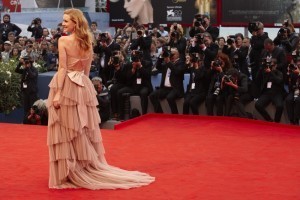 It’s that time of year again: the Venice Film Festival, running from 27 August to 6 September.
It’s that time of year again: the Venice Film Festival, running from 27 August to 6 September.
Did you know that the Venice Film Festival is the oldest film festival in the world? It was first held back in 1932 (the first film shown was Dr. Jekyll and Mr. Hyde), and has run every year since. Originally, the event was fairly private, but these days – this year is the 71st festival – the ‘Mostra’ is quite a show, attracting filmmakers, actors and critics from around the globe, not to mention an army of film fans.
Many of the screenings are held at the Palazzo del Cinema on the Lungomare Marconi in the Lido, and in the vicinity onlookers are treated to the spectacle of celebrities arriving by the boatful on the waterways (and if you’re a Hollywood actress, attempting to step off a water taxi in six-inch heels and a breath-pinching dress is no mean feat!). The city is the perfect atmospheric backdrop to ramp up the grandeur and drama of the proceedings; as film critic Mick LaSalle recently said of the festival:
The city is so arresting, so different from anywhere else, that it upstages the stars. So for once it’s not like they are supplying the aura. It’s more like they’re participating it. Just about every year I end up riding in a boat with some movie star or director, and they do what everybody else does. They stand on the deck and take pictures.
The festival is well-respected as a showcase for work, and its awards are prestigious and coveted. The symbol of the central awards, the Lions, is the winged lion of St. Mark from the flag of the Venetian Republic. The main awards are as follows, with example past winners included in parenthesis:
Golden Lion – best film screened at the festival (Brokeback Mountain, 2005)
Silver Lion – best director (Peter Jackson; Heavenly Creatures; 1994)
VolpiCup – best actor and actress (Colin Firth; actor; A Single Man; 2009)
Special Jury Prize –overall work of a director or actor (Elia Kazan; director; A Streetcar Named Desire; 1951)
There are also prizes for technical contribution, screenplay, set design and music.
‘Juries’ are put together to vote on those films competing for awards. The members are wide ranging in terms of specialisms and nationalities. This year, the main competition will be judged by:
Alexandre Desplat: French composer (President of Jury)
Carlo Verdone: Italian actor and director
Elia Suleiman: Palestinian director
Jessica Hausner: Austrian director
JhumpaLahiri: Indian novelist
Joan Chen: Chinese actress and director
Philip Groning: German director
Sandy Powell: English costume designer
Tim Roth: British actor
Competing films are taken from all over the world. This year, for example, the list of films in the competition herald from United States, Sweden, Norway, Italy, Japan, France, Belgium, Switzerland, China, Turkey, Iran, Germany, Russia, Canada, Poland, Denmark, Finland, Indonesia and the UK.
In addition to those films competing for awards, the festival showcases other films that fit with the overarching Venice Biennale theme and are to be honoured for their contribution to world cinema. The festival has a reputation for being daring and controversial in its choice of films: in 1988, for example, it showed Martin Scorsese’s The Last Temptation of Christ, so scandalising Italian director Franco Zeffirelli that he pulled his latest film from the programme; and in 1999 it premiered Stanley Kubric’s last work, Eyes Wide Shut, which was critically acclaimed but somewhat provoking for its graphic sexual content.
As well as recent films there is a Classics section; this year it includes such gems as the 1968 French romantic comedy Baisersvolés (Stolen Kisses); Roman Polanski’s The Tragedy of Macbeth (1971) and one of my favourite films for its feel-good factor: the 1955 Guys and Dolls starring Marlon Brando, Jean Simmons, Frank Sinatra and Vivian Blaine.
If you’d like to keep up to date on the festival this year and read reviews of the competing films, keep an eye on the following: http://www.theguardian.com/film/venicefilmfestival; http://www.telegraph.co.uk/culture/film/venice-film-festival.

